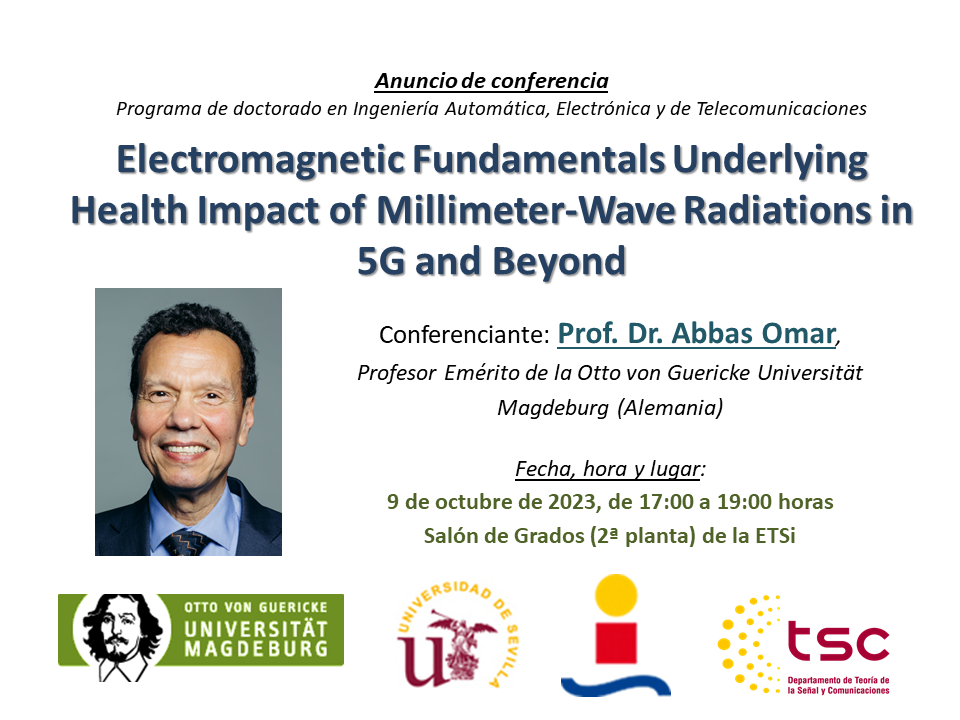Conferencia "Electromagnetic Fundamentals Underlying Health Impact of Millimeter-Wave Radiations in 5G and Beyond"
Conferencia "Electromagnetic Fundamentals Underlying Health Impact of Millimeter-Wave Radiations in 5G and Beyond"
El lunes 9 de octubre, de 17:00 a 19:00 horas, en el Salón de Grados de la Escuela Técnica Superior de Ingeniería de la Universidad de Sevilla, el Prof. Dr. Abbas Omar, profesor emérito de la Otto von Guericke Universität Magdeburg (Alemania) impartirá la siguiente conferencia organizada bajo el programa de doctorado en Ingeniería Automática, Electrónica y de Telecomunicaciones: "Electromagnetic Fundamentals Underlying Health Impact of Millimeter-Wave Radiations in 5G and Beyond"
Resumen: The physical concepts underlying the wave-matter interaction, particularly at millimeter-wave frequencies, are reviewed and discussed in this lecture. Health hazard associated with electromagnetic wave exposures are then discussed. These can generally be categorized in ionizing and non-ionizing effects. Ionization can generally take place in two different scenarios, either because of excessively strong field intensities as the case in, e.g., lightning and corona discharge, or as a result of photon energies exceeding that needed for detaching an outer electron in an atom or breaking a molecular bond. Such photon energies are encountered in radiations of very high frequencies far above the visible spectrum as in, e.g., X- and Gamma Rays. Millimeter-wave radiations encountered in Mobile Communications are extremely low-power, so that their health impact can be either the direct increase in the body temperature or the indirect overloading of the biological processes responsible for the body thermal regulation. This is briefly explained in the following: At wavelengths much larger than the atomic/molecular scale, which is the case in Millimeter and even Tera-Hertz Waves, the continuous spatial distribution of the electromagnetic wave is the proper mathematical representation (as opposed to the quantized photonic one). The wave power-density is described by the Poynting vector, and the power transfer from the wave to the biological substances can be calculated with high precision using the concept of constitutive parameters (conductivity, permittivity, and permeability). These are spectral quantities that fully describe the macroscopic wave-matter interaction under linear steady-state conditions. The weak-tomoderate field intensities characterizing Mobile-Communication signals guarantee the linearity of the wavematter interaction. Furthermore, being moving spatial averages, the per se macroscopic constitutive parameters cannot account for a microscopic wave-matter interaction of specific molecular-scale structures similar to that of, e.g., DNA strand. In addition, the Millimeter Waves suffer from very strong attenuation inside the human body, so that they cannot penetrate deeper than few tenths of a millimeter. Based on the fundamentals stated above, reported adverse effects of Mobile Communication radiations cannot be explained within the framework of the Electromagnetic Theory as long as the involved field intensities are low enough to allow for a linear steady-state application of the theory. The exposure limits dictated by the Regulatory Agencies (e.g. FCC in USA) ensure that. Breve CV del ponente (https://www.hf.ovgu.de/Team/Emeriti/Abbas+Omar.html): Abbas Omar received the B.Sc., M.Sc. and Doktor-Ing. degrees in electrical engineering in 1978, 1982 and 1986, respectively. He has been professor of electrical engineering since 1990 and director of the Chair of Microwave and Communication Engineering at the University of Magdeburg, Germany from 1998 to his retirement in 2020. Universidad de Sevilla Departamento de Teoría de la Señal y Comunicaciones Escuela Técnica Superior de Ingeniería Camino de los descubrimientos s/n 41092 Sevilla SPAIN Tel: +34 954 487 334 e-mail: mjmadero@us.es departamento.us.es/dtsc He joined the Petroleum Institute in Abu Dhabi as a Distinguished Professor in 2012 and 2013 as an organizer of the research activities for the Oil and Gas Industry in this area. In 2014 and 2015 he chaired the Electrical and Computer Engineering at the University of Akron, Ohio, USA. Dr. Omar authored and co-authored more than 480 technical papers extending over a wide spectrum of research areas. His current research and teaching fields cover the areas of health aspects of millimeter-wave radiations, quantum computing, phased arrays and beamforming for massive MIMO, and magnetic- resonance imaging. He also covered in the past other disciplines including microwave and acoustic imaging, microwave and millimeter-wave material characterization, indoor positioning, subsurface tomography and ground penetrating radar, and field theoretical modeling of microwave systems and components. Dr. Omar is IEEE Fellow.

